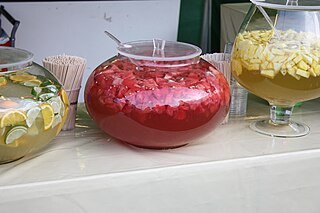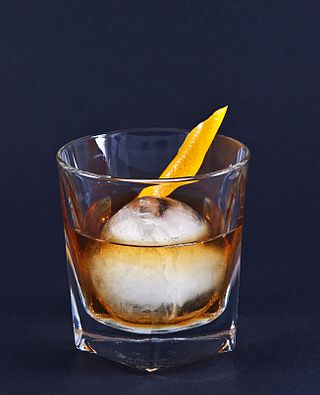
A cocktail is an alcoholic mixed drink. Most commonly, a cocktail is a combination of one or more spirits mixed with other ingredients, such as juices, flavored syrups, tonic water, shrubs, and bitters. Cocktails vary widely across regions of the world, and many websites publish both original recipes and their own interpretations of older and more famous cocktails.

Mulled wine, also known as spiced wine, is an alcoholic drink usually made with red wine, along with various mulling spices and sometimes raisins, served hot or warm. It is a traditional drink during winter, especially around Christmas. It is usually served at Christmas markets in Europe, primarily in Germany, Czech Republic, Austria, Switzerland, Slovenia, Croatia, Romania, Nordics, Baltics and eastern France. There are non-alcoholic versions of it. Vodka-spiked mulled wine can be found in Polish Christmas markets, where mulled wine is commonly used as a mixer.

Compote or compôte is a dessert originating from medieval Europe, made of whole or pieces of fruit in sugar syrup. Whole fruits are cooked in water with sugar and spices. The syrup may be seasoned with vanilla, lemon or orange peel, cinnamon sticks or powder, cloves, other spices, ground almonds, grated coconut, candied fruit or raisins. The compote is served either warm or cold.

Squash, is a non-alcoholic beverage with concentrated syrup used in beverage making. It is usually fruit-flavoured, made from fruit juice, water, and sugar or a sugar substitute. Modern squashes may also contain food colouring and additional flavouring. Some traditional squashes contain herbal extracts, most notably elderflower and ginger.

In cooking, syrup is a condiment that is a thick, viscous liquid consisting primarily of a solution of sugar in water, containing a large amount of dissolved sugars but showing little tendency to deposit crystals. In its concentrated form, its consistency is similar to that of molasses. The viscosity arises from the multiple hydrogen bonds between the dissolved sugar, which has many hydroxyl (OH) groups.

The term punch refers to a wide assortment of drinks, both non-alcoholic and alcoholic, generally containing fruits or fruit juice. The drink was introduced from the Indian subcontinent to England by employees of the East India Company in the late 17th century. Punch is usually served at parties in large, wide bowls, known as punch bowls.

Eggnog, historically also known as a milk punch or an egg milk punch when alcoholic beverages are added, is a rich, chilled, sweetened, dairy-based beverage. It is traditionally made with milk, cream, sugar, egg yolks, and whipped egg whites. A distilled spirit such as brandy, rum, whiskey or bourbon is often a key ingredient.
Drink mixers are the non-alcoholic ingredients in mixed drinks and cocktails. Mixers dilute the drink, lowering the alcohol by volume in the drink. They change, enhance, or add new flavors to a drink. They may make the drink sweeter, more sour, or more savory. Some mixers change the texture or consistency of the drink, making it thicker or more watery. Drink mixers may also be used strictly for decorative purposes by changing the color or appearance of the drink. They also simply increase the volume of a drink, to make it last longer.

A flip is a class of mixed drinks. According to the Oxford English Dictionary, the term was first used in 1695 to describe a mixture of beer, rum, and sugar, heated with a red-hot iron. The iron caused the drink to froth, and this frothing engendered the name. Over time, eggs were added and the proportion of sugar increased, the beer was eliminated, and the drink ceased to be served hot.

There are many cocktails made with cachaça, the national spirit of Brazil. The caipirinha is by far the most popular and internationally well-known, but bartenders have developed other mixed drinks using the spirit.

Mizrahi Jewish cuisine is an assortment of cooking traditions that developed among the Jews of the Middle East, North Africa, Asia, and Arab countries. Mizrahi Jews have also been known as Oriental Jews.

Ginger tea is a herbal beverage that is made from ginger root. It has a long history as a traditional herbal medicine in East Asia, South Asia, Southeast Asia, and West Asia.

Masala chai is a popular beverage throughout South Asia, originating in the early modern Indian subcontinent. Chai tea is made by brewing black tea in milk and water and then sweetening with sugar. Adding aromatic herbs and spices creates chai tea, although chai is often prepared unspiced.

Sharbat is a drink prepared from fruit or flower petals. It is a sweet cordial, and usually served chilled. It can be served in concentrated form and eaten with a spoon or diluted with water to create the drink.

A whiskey cocktail is a cocktail that includes whiskey. Although whiskey is often served neat or on the rocks, it is used in many classic cocktails such as the Old Fashioned, Manhattan, and Julep. Some specifically call for Scotch whisky or bourbon whiskey.















